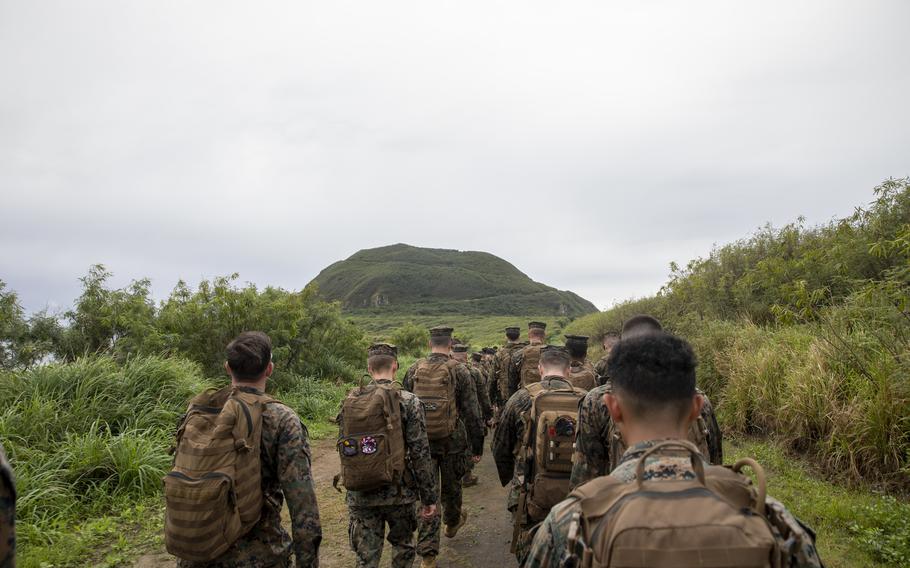
U.S. Marines and sailors hike towards Mt. Suribachi on Iwo Jima, Japan, on Dec. 13, 2022. (Lance Cpl. David Getz/U.S. Marine Corps)
AUSTIN, Texas (Tribune News Service) — Retired Maj. John Keith Wells served in the U.S. Marines and led the charge to raise the first American flag above Mt. Suribachi during the battle of Iwo Jima.
Born in Lakeview, Texas, Wells said he kept busy as a child, especially after his mother died of cancer when he was just ten years old.
Wells said he was an only child and he learned quickly how to do things and began driving and making deliveries to customers from the meat market in town. His childhood also included an abundance of friends and he also excelled in sports, lettering in every sport he played. Following high school, Wells said he went to Texas A&M.
While A&M was a military school, Wells said he didn’t really enroll there with the intention of joining the military. He said one of his father’s cousins went there and they had the best football team in the country.
“I had bought a small radio and had it racked up and it was on Sunday morning, and I was going to stay in school and do a little studying, and so I was studying and whatever, and turned that little radio on and all of a sudden it come on that Pearl Harbor was being bombed,” Wells said, adding he knew he’d be headed to the war.
I immediately contacted one of those Marines, and there just wasn’t many of them around, and talked to him and he, in a week or two he called me and he said say, there’s a Marine recruiting officer down on the coast, so I just hitchhiked down to Houston and found him and joined the Marine Corps.”
Wells attended basic training on Parris Island, a training depot the U.S. Marines have used during each major conflict of the 20th and 21st Century. Following training, Wells said they didn’t go to infantry school like he thought, instead they were sent by train to Officer Candidate School at Quantico because at the time, the United States wasn’t in control of the sea waters.
“They put us on a train and sent us to Quantico in this train and the train was blacked out, and hot, my gosh. Well we just, I just got down on the floor and laid in the dirt on the floor and there was no lights on the train and it was that type of thing. We pulled into Quantico, and I tell you, the people looked at us and we sure didn’t look like officers,” Wells said.
Wells said he went from Officer Candidate School at Quantico to Marine Parachute Training School in El Cajon, California. He vividly remembered his second to last jump in school when he broke his leg, but he didn’t let that stop him from completing what he set out to do.
“The officers looked at me, but I’d been helping them some in various things so they didn’t say anything, and I went ahead and jumped with that broke leg,” Wells said.
Following Marine Parachute Training School, Wells was deployed to Guadalcanal with the 1st Marine Regiment in December 1943. Once he returned, he was given command of the 3rd Platoon, Easy Company, 2nd Battalion, 28th Marines, 5th Marine Division, a platoon he would take to Iwo Jima. Wells was asked what he told his men before they went ashore ahead of what would be a historic battle for the history books.
“They found out real quick that we were gonna be doing probably whatever we’re doin’ there, we’re gonna be doin’ it a little bit different than anybody else, and that turned out to be true,” said Wells.
Wells and his team were quickly given the task of leading an assault at the base of Mt. Suribachi, an attack that resulted in Wells getting wounded and evacuated to a hospital ship.
“There was a big, big, big opening there, and of course all the weapons that you can think of that they would have, they had it zeroed, and that’s when they got me,” Wells said about getting wounded.
Wells would escape the hospital ship, convincing a corpsman to supply him with sulfa powder and morphine so he could rejoin his platoon shortly after the first flag was raised atop Mount Suribachi. Once Wells reached the base of Mount Suribachi he was helped to the summit by one of the flag raisers, Charles Lindberg.
“We got the platoon on Iwo Jima, got one Congressional Medal of Honor, three Navy Crosses, one Silver Star, platoon sergeant promoted to lieutenant, and over 100 percent Purple Hearts,” Wells recalled about the heroism on display when Iwo Jima was taken by his American forces. “We were the most decorated platoon ever to come out of a single engagement in the history of the United States.”
© 2025 the Odessa American (Odessa, Texas).
Visit www.oaoa.com.
Distributed by Tribune Content Agency, LLC.